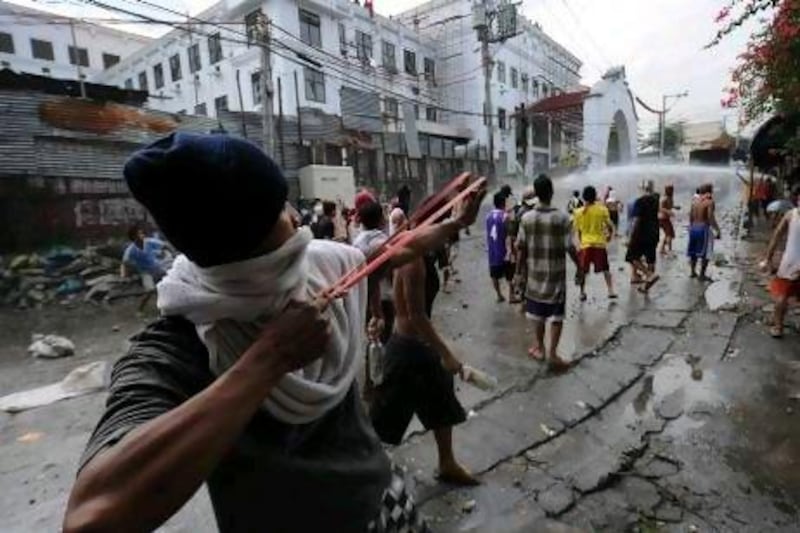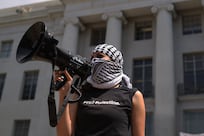MANILA // The women and children of a shantytown in the Philippine capital huddled along an alleyway while the men battled riot police nearby in a last-ditch stand to save their homes.
Many of the 600 residents had lived in the shantytown in the centre of Metro Manila all of their lives but, without any formal legal title to their homes, were being evicted to make way for a new town hall.
"They treated us like criminals," said Vicky Balabor, a 47-year-old mother of three after the hour-long confrontation that saw riot police fire water cannons and tear gas at the men of the neighbourhood.
The men resisted with petrol bombs, rocks and bottles, but numbering only a few dozen, were no match for the roughly 500 riot police who paved the way for demolition crews armed with crowbars to tear down the shantytown.
Twenty-two people were injured, including residents, police and demolition crew members, while 13 men defending their homes were arrested, in January's skirmish, according to the local city council spokeswoman, Grace Cortes.
The clearing of Pinaglabanan, an eight-hectare park, was just one of many battles that regularly erupt pitting Manila's giant "informal settler" community against authorities or property developers who want the land.
More than two million people in Metro Manila - or roughly one fifth of the sprawling city's population - live in shanty towns as so-called informal settlers.
The urban blight is worsening as the Philippines' population continues to expand at one of the fastest rates in the world, and people from rural areas head to Manila and other cities in search of work.
The phenomenon sees squatters take over parcels of vacant land and build shanties.
With grinding poverty stripping away choices for the desperate squatters, almost any type of vacant land is considered an opportunity with some shantytowns built on top of public cemeteries and many in flood-prone areas. But while the squatters do not have formal rights to the land, Philippine law makes it hard for the owners - whether they be the government or private interests - to get it back.
A 1992 law states that demolitions and evictions will not be allowed unless the settlers occupy dangerous areas, when the site is needed for public infrastructure projects, or when there is a court order.
Some politicians also encourage the settlers to stay so they can be used as reliable supporters in elections, while high-profile protests or battles such as the one seen in Pinaglabanan can buy extra time for squatters.
In the Pinaglabanan case, the eviction occurred only after lengthy legal proceedings, with the local council winning court approval to demolish the slum 12 months earlier to make way for the town hall.
In one incident showing the strength of informal settler communities, President Benigno Aquino suspended a 22 billion peso (Dh1.89bn) project to turn some government land in Manila into a business and shopping district in 2010 after squatters fought police to prevent the eviction of 6,000 families.
The government was also forced to fight all the way to the Supreme Court in 2007 for permission to evict 20,000 squatter families from the former army headquarters in Manila.
After winning the legal challenge, the area was turned into an upscale business, residential and retail district called The Fort that has become one of the capital's most prestigious districts.
About 3.5 million low-cost homes need to be built across the country to address the squatter problem, according to Antonio Bernardo, chief executive of the national government's Housing and Land Use Regulatory Board.
He said the national and local governments were implementing programmes to try to move squatters out of dangerous areas and into formal communities, giving them financial incentives to do so such as low-interest loans.
Mr Bernardo also pointed to a law that said one out of every five homes built by Philippine developers must cost under 400,000 pesos.
But Arturo Corpuz, vice president and urban planning chief for Ayala Land, the country's largest property firm, said these low-cost homes were beyond the reach of many informal settlers. And many of the areas where informal settlers are asked to move are further away from parts of Manila where work can be found.
Ms Balabor and others in the group cleared from Pinaglabanan in January were going to be taken by lorry to live in low-cost homes at a mountainous site in Rodriguez, about 20 kilometres away.
Under the local government's relocation scheme, they can live in the small concrete homes in Rodriquez for free for one year, but will then have to start paying the monthly mortgage of about US$175.
But Balabor, 47, earns just $220 (Dh643) a month working as a cleaner at Manila call centre, while her carpenter husband is out of work.
Even the bus ride from her planned new home to her workplace would cost a third of her salary every month.
Balabor said her family had no choice but to move to Rodriquez for the moment, but she had no idea how they could meet the mortgage payments in a year's time.
"We just don't know what we're going to do," she said.





